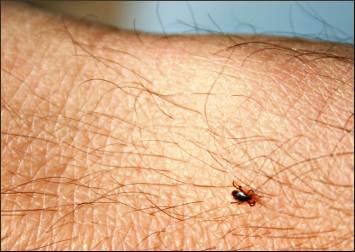How to prevent Lyme disease
The bite of a deer tick can cause major headaches, and more.

© Beth Gauper
In the woods, the first ticks appear as soon as snow starts to melt, and they're out en masse when warmer weather arrives in April and May.
Regular ticks are bad enough, scuttling into hidden niches on the human body and gorging themselves on blood. But their ick factor pales next to the danger posed by black-legged ticks, which can transmit Lyme and other diseases.
Black-legged ticks, also known as deer ticks, need to be attached to the skin for 24 to 36 hours to transmit the disease. Even then, it's usually treated easily if caught promptly.
But if untreated, symptoms include fatigue, fever and achiness; eventually, it can lead to nerve damage, chronic joint pain and even neurological problems.
Wisconsin is the epicenter of Lyme disease in the Upper Midwest, according to the Centers for Disease Control and Prevention.
However, the number of cases is declining in Wisconsin as well as Minnesota.
Field studies in Minnesota have shown that about one-third of adult ticks and one in five young ticks, called nymphs, carry the bacteria that causes Lyme disease.
The incidence of the disease is even higher in New England.
Here are the best ways to prevent infection.
Tuck in shirts and pants. To make ticks easier to see, wear light-colored clothing. Nymphs may look like a moving freckle.
Spray skin and clothing with bug spray containing 30 percent DEET, or spray clothing with Permethrin clothing repellent. Some outdoors people even soak pants in it. An aerosol can that will spray three sets of clothing costs $15-$20. They're available online and at outdoors stores.
Run hands over skin to detect the smaller ticks, then again in the shower.

© Beth Gauper
If you find one, grasp its head gently, with tweezers or your fingers, and pull it out slowly. Then, disinfect the bite site.
People who have to remove a lot of ticks from themselves or their dogs swear by the Tick Key and Tick Twister remover tools.
Ticks also can hide in the folds of clothing or boots and crawl onto the body later. Putting clothing in a dryer on high heat for at least 10 minutes will kill them.
And here's an ingenious idea: Wrap a strip of duct tape, sticky side out, around your cuffs to keep ticks from crawling up your legs and arms, especially if you will be walking in brush or long grass.
If you want to be especially safe, wrap the tape around your collar, too, to keep them out of your hair — although ticks don't drop out of trees, and can get to your head by crawling.
If you spend a lot of time in tick country, and you think you still might get bitten, some doctors recommend you get an advance prescription for a one-time, 200 milligram dose of the antibiotic doxycycline. You still need to go to the doctor, but at least you can get a head start on treatment.
Depending on location, says Dr. Russell Johnson, a microbiologist who studies agents of Lyme disease at the University of Minnesota, 40 to 60 percent of adult female black-legged ticks carry Lyme disease.
The first ticks out mostly are adults; the nymphs that appear from mid-May to early July carry the disease at about half that rate, but all are looking for blood meals and are harder to see.
Deer-tick nymphs appear as black dots, the size of a poppy seed; adults are the size of a sesame seed.
About 80 percent of people will develop an even red rash that may look like a bull's-eye rash, Johnson said.
But even if you don't, and you develop an unexplained fever or ache about two weeks after spending time in woods, consider the possibility of Lyme disease.
You may need to be a firm advocate for yourself, as some doctors are not well-informed about tick-borne diseases. The tests for Lyme look for antibodies, which the body doesn't develop immediately, so early tests often result in a false negative.
Robert Sitko of Stillwater, Minn., a beekeeper who tends apiaries in the heavily infested St. Croix River Valley and likes to go camping, knew he was at risk. One year, he saw the tell-tale bull's-eye rash of Lyme disease on his body and went to a doctor, who prescribed three weeks of antibiotics.
That was that — until a year later, when he ran a 105-degree fever and landed in the hospital. That time, it was anaplasmosis, also known as ehrlichiosis, another bacterium transmitted by deer ticks.
Now, Sitko does everything he can to avoid being bitten by a deer tick. He tucks his pants legs into his socks. He checks skin and clothes religiously. He uses insect repellents.

© Lymenet.org
He might have taken the vaccine if it hadn't been discontinued for human use, but he gets a shot of it for his German shorthair dog every year.
And after he found a deer tick while cutting trees in his back yard, he drove to a sporting-goods store and bought a canister of Permethrin clothing repellent.
"What you do is spray it on your clothes, let it dry two hours, and it's supposed to last six weeks or six washings," he said. "Supposedly, it kills ticks on contact. I thought, that's the perfect thing for people going on a week's camping trip."
Microbiologist Johnson confirms that the product does work.
"It works very well," he says. "In fact, it kills ticks within seconds of contact."
Western Wisconsin and the St. Croix Valley of Minnesota are considered hot spots for Lyme-carrying deer ticks, but they've expanded their range northward and westward to northern Minnesota, Johnson said.
More information
The Minnesota DNR has a page about deer ticks. The Wisconsin Department of Health Services has a page about ticks and the many diseases they carry, not just Lyme.
The Minnesota DNR's Conservation Volunteer magazine includes an interesting story about how outdoors people deal with ticks.
The Centers for Disease Control offers comprehensive information, including the signs and symptoms of Lyme disease.
In a fascinating story about " The Rise of the Tick," Outside magazine quotes the Institute of Medicine declaring ticks "the Swiss Army knife of disease vectors."
Business Insider calls Lyme a "hidden epidemic" that has "ballooned into a public-health fiasco."
In 2016, the New York Times reported that a new strain of tick-borne bacteria had been found in the Upper Midwest.